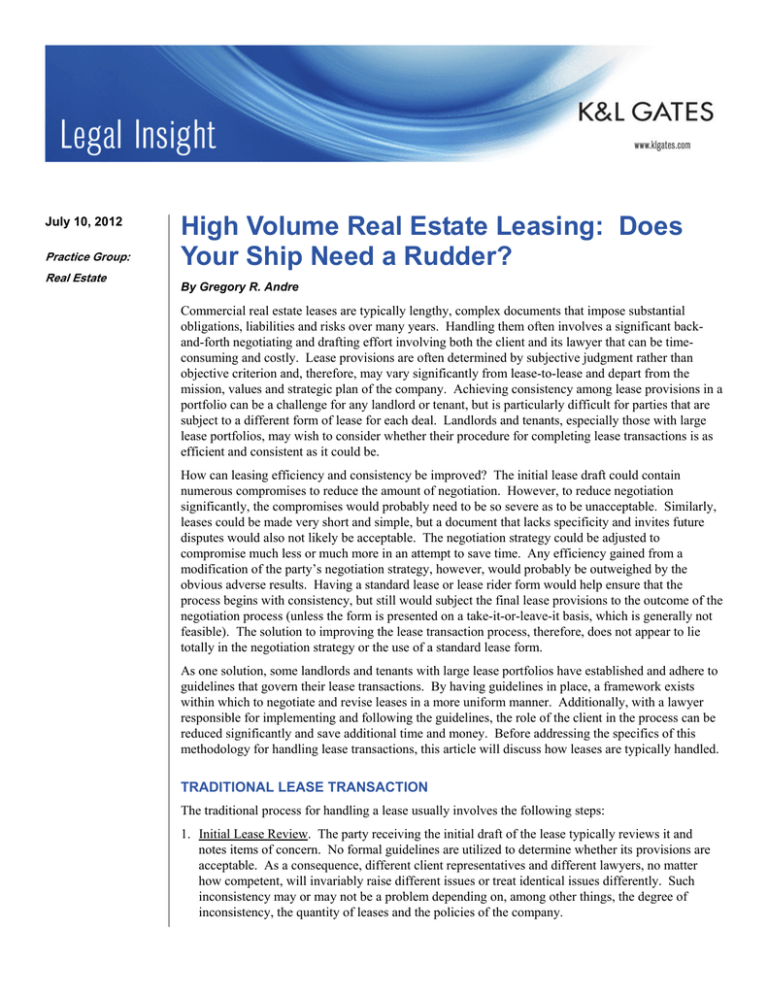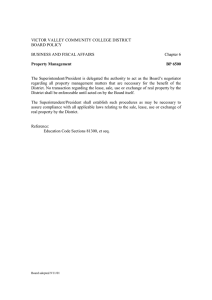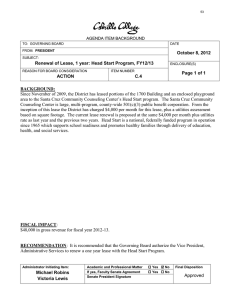High Volume Real Estate Leasing: Does
advertisement

July 10, 2012 Practice Group: Real Estate High Volume Real Estate Leasing: Does Your Ship Need a Rudder? By Gregory R. Andre Commercial real estate leases are typically lengthy, complex documents that impose substantial obligations, liabilities and risks over many years. Handling them often involves a significant backand-forth negotiating and drafting effort involving both the client and its lawyer that can be timeconsuming and costly. Lease provisions are often determined by subjective judgment rather than objective criterion and, therefore, may vary significantly from lease-to-lease and depart from the mission, values and strategic plan of the company. Achieving consistency among lease provisions in a portfolio can be a challenge for any landlord or tenant, but is particularly difficult for parties that are subject to a different form of lease for each deal. Landlords and tenants, especially those with large lease portfolios, may wish to consider whether their procedure for completing lease transactions is as efficient and consistent as it could be. How can leasing efficiency and consistency be improved? The initial lease draft could contain numerous compromises to reduce the amount of negotiation. However, to reduce negotiation significantly, the compromises would probably need to be so severe as to be unacceptable. Similarly, leases could be made very short and simple, but a document that lacks specificity and invites future disputes would also not likely be acceptable. The negotiation strategy could be adjusted to compromise much less or much more in an attempt to save time. Any efficiency gained from a modification of the party’s negotiation strategy, however, would probably be outweighed by the obvious adverse results. Having a standard lease or lease rider form would help ensure that the process begins with consistency, but still would subject the final lease provisions to the outcome of the negotiation process (unless the form is presented on a take-it-or-leave-it basis, which is generally not feasible). The solution to improving the lease transaction process, therefore, does not appear to lie totally in the negotiation strategy or the use of a standard lease form. As one solution, some landlords and tenants with large lease portfolios have established and adhere to guidelines that govern their lease transactions. By having guidelines in place, a framework exists within which to negotiate and revise leases in a more uniform manner. Additionally, with a lawyer responsible for implementing and following the guidelines, the role of the client in the process can be reduced significantly and save additional time and money. Before addressing the specifics of this methodology for handling lease transactions, this article will discuss how leases are typically handled. TRADITIONAL LEASE TRANSACTION The traditional process for handling a lease usually involves the following steps: 1. Initial Lease Review. The party receiving the initial draft of the lease typically reviews it and notes items of concern. No formal guidelines are utilized to determine whether its provisions are acceptable. As a consequence, different client representatives and different lawyers, no matter how competent, will invariably raise different issues or treat identical issues differently. Such inconsistency may or may not be a problem depending on, among other things, the degree of inconsistency, the quantity of leases and the policies of the company. High Volume Real Estate Leasing: Does Your Ship Need a Rudder? Furthermore, it is common for both the client and its lawyer to review the lease. After they have reviewed the lease, they typically discuss the issues and determine their position with respect to each of them. Having two (or more) people review and discuss the lease internally might be perfectly appropriate and acceptable for certain clients or certain transactions. Substantial, unique or infrequent transactions might warrant such an effort. However, for many other lease transactions, a streamlined process might be worth considering. 2. Negotiation and Document Revision. Normally, after the client and its lawyer have discussed the lease issues, the negotiation process with the other party begins. The process often involves a significant back-and-forth effort as the lease is reviewed and lease issues are discussed both internally between the lawyer and the client and externally between the lawyers (with or without their respective clients). This process is generally repeated until the lease is mutually acceptable (or negotiation ends and the deal terminated). As with the initial lease review, having two (or more) people review and discuss the lease internally with each turn of the lease might be reasonable and necessary to some companies or unnecessarily duplicative to others. Throughout this process of lease negotiation and document revision, typically no formal guidelines are followed, and it may not be clear to those handling the lease whether its provisions are consistent with company policy. The subjective judgment of the individuals handling the lease is usually relied upon to determine whether the lease is acceptable, perhaps with certain major issues being resolved by senior management. For certain clients and certain types of leases, this approach might be completely satisfactory. However, as different client representatives and lawyers handle leases for the company, the risk of problems associated with inconsistencies in the drafting and substance of lease provisions increases. This is especially likely where leasing is handled on a decentralized basis, such as each region or division of a company handling leases within its jurisdiction as the region or division personnel deem appropriate. 3. Lease Portfolio. For landlords and tenants that have a small number of leased properties or have leases that are substantial in size or unique, then following the traditional lease transaction process summarized above may be entirely appropriate. In such cases, developing formal guidelines may not be worth the effort; inconsistency might not present any problems; and some overlap or duplication of internal effort between the client and the lawyer might be immaterial and, possibly, prudent. However, if a landlord or a tenant has a large number of leased properties and there are not overriding unique characteristics for each lease transaction, then the issues of inefficiency and inconsistency with respect to leasing become magnified and, for some, unacceptable. When provisions vary significantly from lease-to-lease, it might indicate that the aggregate obligations, liabilities and risks that the company has assumed in each separate lease deviate unacceptably from the company’s mission, values and strategic plan. Allowing such a fact situation to exist may also render future business decision-making difficult for the company. For example, if a retail tenant with numerous stores has no pre-determined policy as to whether its leases must have the right to “go dark” (cease operations and continue to pay rent) and it wishes to close its 100 lowest performing stores, it will need to read 100 leases to know if such rights exist, probably discover that many leases lack such rights and be forced to change its plans for those stores, and then deal with different going-dark requirements for the leases that have such rights. Budgeting and planning for lease liabilities and risks which are difficult to predict and quantify, such as indemnities and repairs, become more troublesome when the lease provisions governing them vary significantly because each lease requires a different analysis. Issues with differing lease 2 High Volume Real Estate Leasing: Does Your Ship Need a Rudder? provisions in a portfolio can arise under many circumstances, such as opening or closing facilities, financing, the sale of properties and mergers and acquisitions. It is clearly better to avoid such lease issues in the first place than to discover them unexpectedly and be required to react to them during such events. AN ALTERNATIVE LEASE TRANSACTION METHOD Although the traditional method of handling commercial real estate lease transactions may be perfectly acceptable to many landlords and tenants, some landlords and tenants seek a more streamlined and cost-effective process that achieves uniformity across their lease portfolios and ensures the proper implementation of company policy. This alternative method is discussed below. 1. Lease Guidelines. The first step towards streamlining the process and achieving consistency is to develop guidelines that set forth the parameters within which all leases must comply. The guidelines are usually tailor-made to suit the needs of each company. The scope of the guidelines can range from addressing only the major lease provisions to encompassing virtually every lease provision. For example, a client might develop guidelines for only 10 critical lease provisions or for 50 or more of the most common lease provisions. Of course, guidelines should require that the lease accurately reflect business and other terms set forth in any letter of intent, term sheet or similar document. Leasing guidelines can be drafted in many ways. They can be expressed in conceptual terms, such as “indemnities shall not cover more than personal injury and property damage to the extent caused by our negligence.” They also can be drafted to require that all leases contain certain predetermined, specifically worded provisions verbatim and without deviation. Whether drafted conceptually or using specific terms, the guidelines also may provide for less desirable, but acceptable, fallback positions. The guidelines also could consist of a checklist to confirm certain lease items (e.g., “the lease does not require any subleasing profits to be shared with the landlord”). Finally, some guidelines allow for exceptions only if a special approval is obtained by a senior representative of the company for the deviation. The process of developing guidelines itself is worthwhile because it forces a company to engage in the exercise of determining the acceptable level of obligations, liabilities and risks it is willing to assume and whether they comport with the business plan for the company. Creating leasing guidelines takes some time and effort, but its benefits in terms of efficiency and consistency will be realized on an entire lease portfolio for a long time and should far outweigh the initial burden of establishing them. 2. Negotiation and Document Revision. Leasing guidelines provide a road map for the client and the lawyer to follow when negotiating and drafting leases and result in consistent lease provisions throughout a lease portfolio. The final lease provisions might not all be identical, but a well conceived and drafted set of leasing guidelines consistently applied can help ensure that all of the company’s leases fall within an acceptable range. Even if different representatives and lawyers are handling the leasing transactions for a particular company, the leases all will be handled in the same manner and will adhere to certain tolerance parameters. Guidelines also provide the opportunity to streamline the internal review process and save time and money as a result. When a company has established lease guidelines and a new lease transaction arises, the lawyer can follow the guidelines and perhaps single-handedly go through the process of review, negotiation and document revision. The client need not review the lease or be involved in 3 High Volume Real Estate Leasing: Does Your Ship Need a Rudder? the negotiations in great detail because it knows that the lease will be completed within the limits of the guidelines. At the conclusion of the negotiation and document revision process, the client needs to have only one question answered by its lawyer: “Does the lease comply with the guidelines?” If it complies and there were no issues presented that were not addressed by the guidelines, then the lease can be executed. If it does not comply, then the lawyer and the client discuss how to resolve the particular provisions that do not comply with the guidelines or, if the guidelines do not allow for any exceptions, the deal is terminated. Therefore, instead of the client and the lawyer both reviewing each iteration of the lease and both discussing the issues presented by each revised draft of the lease, all of which can consume a tremendous amount of time and effort, the lease guidelines permit the lawyer to complete the task without duplication or overlap of effort and in much less time. The guidelines, if well drafted and reasonably comprehensive, allow the client to focus only on the few lease provisions, if any, that deviate from or are not addressed by the guidelines, as opposed to focusing on the entire lease and its numerous issues as each draft is generated. Additionally, having a defined set of standards in place sometimes can provide a negotiating advantage. Announcing that company policy prohibits a certain provision unless a special approval is obtained just might help to win the point and expedite the execution of the lease. The table below compares the process of handling leases in a traditional manner with the alternative process of utilizing leasing guidelines from the perspective of the party receiving an initial draft lease from the other party (but guidelines can be beneficial to both parties, regardless of which party controls the drafting and revision of the document). Traditional Lease Process Lease Guideline Process N/A Guidelines created (a one-time task) Lawyer reviews 1st draft Lawyer reviews 1st draft Client reviews 1st draft N/A st Lawyer and client discuss 1 draft issues N/A Lawyer negotiates 1st draft with other lawyer Lawyer negotiates 1st draft with other lawyer Lawyer reviews 2nd draft Lawyer reviews 2nd draft Client reviews 2nd draft N/A nd Lawyer and client discuss 2 draft issues nd N/A Lawyer negotiates 2 draft with other lawyer Lawyer negotiates 2nd draft with other lawyer Lawyer reviews 3rd/final draft Lawyer reviews 3rd/final draft Client reviews 3rd/final draft N/A rd Lawyer and client discuss 3 /final draft N/A N/A Lawyer informs client that 3rd/final lease complies with guidelines Client executes lease Client executes lease 4 High Volume Real Estate Leasing: Does Your Ship Need a Rudder? 3. Lease Portfolio. Without leasing guidelines, the reality is that 10 different lawyers handling the same lease will negotiate and draft it 10 different ways. With guidelines, no matter how many client representatives and lawyers are handling an entire lease portfolio, they will all be completed in a relatively consistent manner. Leasing guidelines ensure quality control. In addition, a portfolio of leases completed pursuant to guidelines will have a consistent level of obligations, liabilities and risks, and the relevant obligations, liabilities and risks can be readily ascertained by a quick check of the guidelines and any exceptions approved for an individual lease, as opposed to a detailed examination of every lease in the portfolio. The consistency and recordkeeping afforded by lease guidelines facilitates business planning and the implementation of company initiatives. For example, if a company wishes to assign its leases on 50 facilities, the leasing guidelines might indicate that for 47 of the facilities, it can assign the leases on identical or consistent terms, and only three leases deviate from the guidelines. Indeed, in order for a company to make any significant business decision, it will need to have a clear understanding of the company’s overall income, expenses and exposure to contingent liabilities, and lease guidelines facilitate that analysis. Finally, where a large portfolio of leased property represents a substantial asset of, and source of liability and risk for, a company, it is important that the company’s leases reflect the mission, values and strategic plan of the company. Leasing guidelines can, and should be, designed to achieve that objective. CONCLUSION As companies strive to wring efficiency out of their business processes and reduce expenditures, the manner in which they handle lease transactions frequently is worth examining, especially for companies with large lease portfolios. Some companies have developed leasing guidelines to both streamline the process of lease negotiation and document revision and achieve consistency with respect to the obligations, liabilities and risks associated with their lease portfolios. While the creation of leasing guidelines represents a one-time extra step, the additional up-front effort should pay dividends in terms of efficiency and consistency. The content of the leasing guidelines and how they are implemented can be tailor-made to suit the needs of any company. The author thanks his partner, Pierce Richardson, for his insightful comments on this article. Author: Gregory R. Andre greg.andre@klgates.com +1. 312.807.4254 5 High Volume Real Estate Leasing: Does Your Ship Need a Rudder? 6




